Determining Which Sine Wave Frequencies Correspond to Signal and Which Correspond to Noise in Eye-Tracking Time-Series
Abstract
:Introduction
“For oscillating eye-movements, such as tremors, we can argue based on the Nyquist-Shannon sampling theorem (Shannon, 1949) that the sampling frequency should be at least twice the speed of the particular eye movement (e.g., behavior at 150 Hz requires >300 Hz sampling frequency)” (Andersson et al., 2010).
Methods
Subjects
Eye Movement Data Collection
Selection of Saccade, Catch-up Saccade and Microsaccade Exemplars
Signal Frequency Content Analysis
Calculation of Percentage of Variance Accounted For (PVAF)
Study of the Effects of Filtering on the Main Sequence Relationship between Saccade Peak Velocity and Saccade Amplitude
Results
Analysis of Exemplars
Saccades
Microsaccade
Smooth Pursuit and Catch-up saccades (CUS)
Percentage of Variance Accounted For (PVAF)
Effects of Filtering on the Main Sequence Relationship between Saccade Peak Velocity and Saccade Amplitude
Summary of Results
Discussion
Conclusion
Data Availability Statement
Ethics and Conflict of Interest
Acknowledgments
Appendix
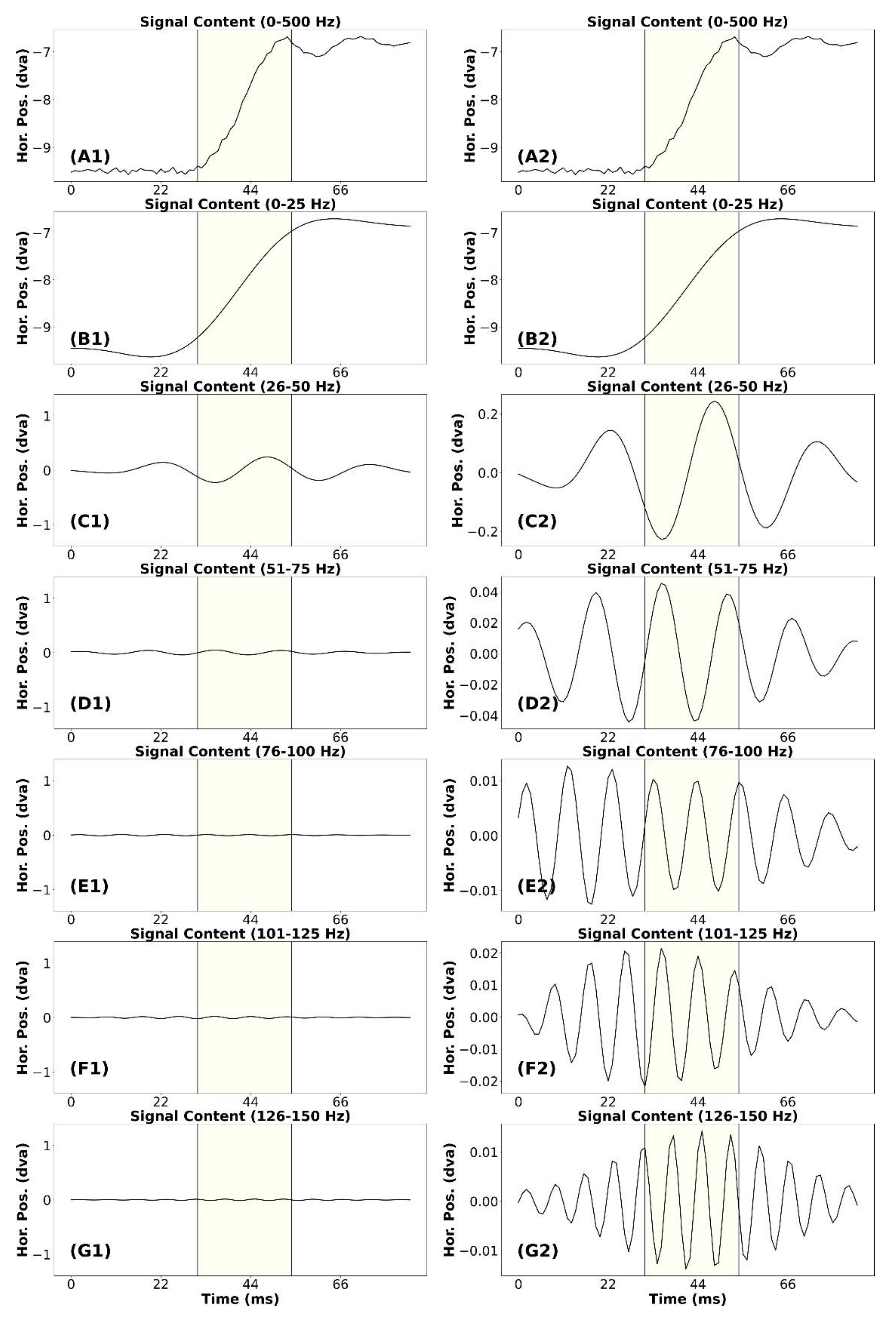

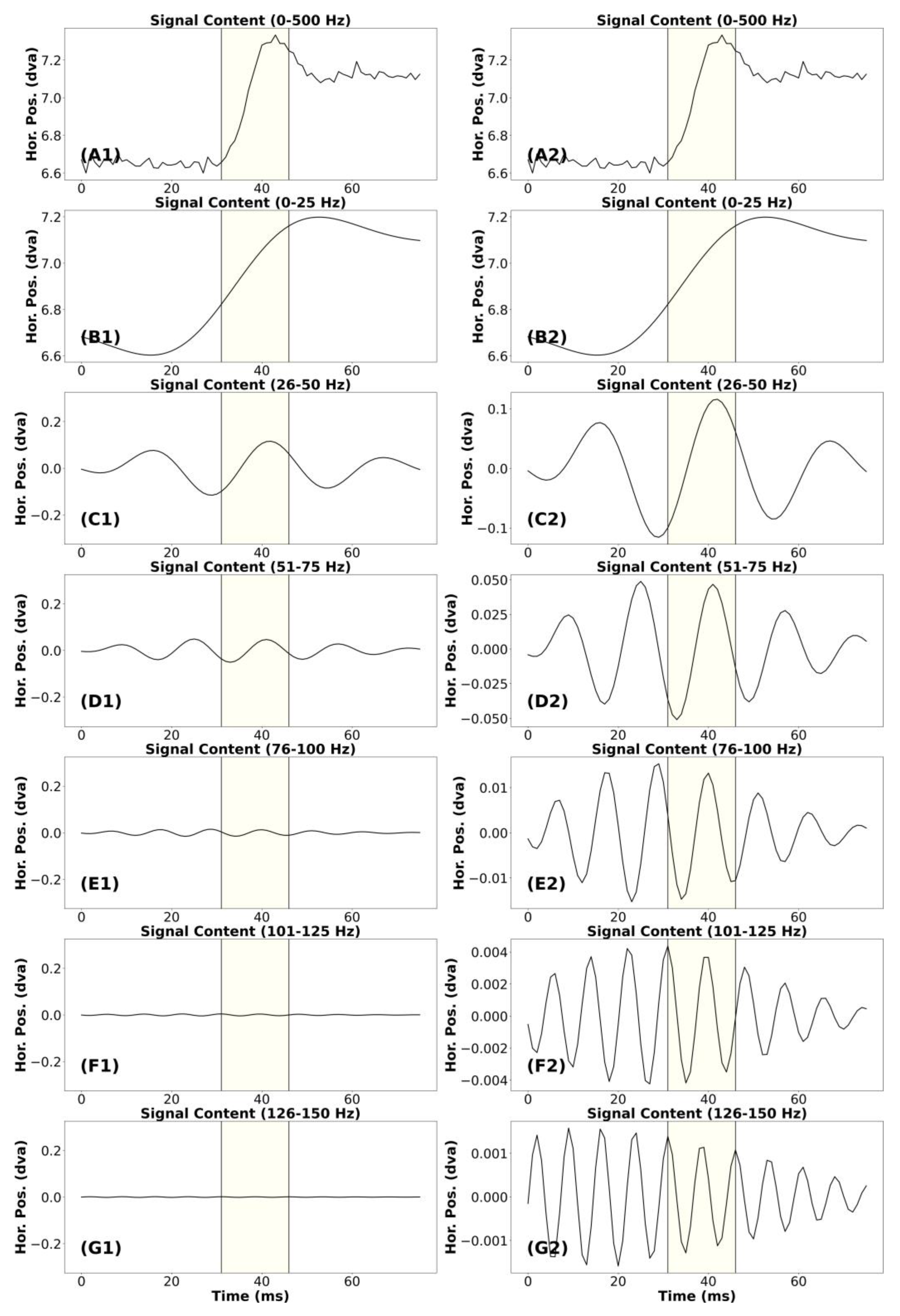
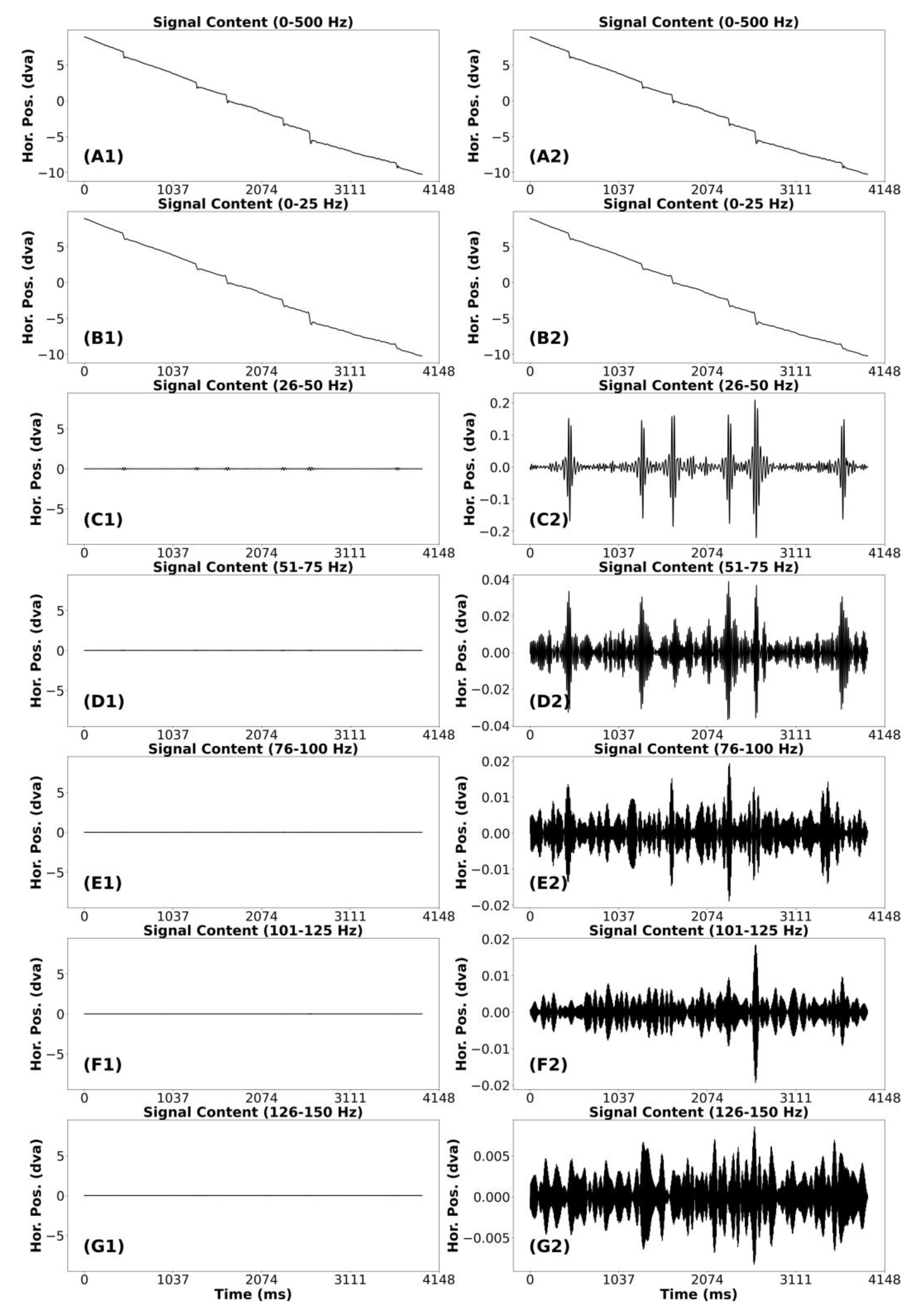

References
- Andersson, R., M. Nystrom, and K. Holmqvist. 2010. Sampling frequency and eye-tracking measures: how speed affects durations, latencies, and more. Journal of Eye Movement Research 3, 3. [Google Scholar] [CrossRef]
- Bahill, A. T. 1981. Variability and Development of a Normative Data-Base for Saccadic Eye-Movements. Investigative Ophthalmology & Visual Science 21, 4: 630–630. Available online: https://pubmed.ncbi.nlm.nih.gov/7251295/.
- Friedman, L., J. A. Jesberger, and H. Y. Meltzer. 1991. A Model of Smooth Pursuit Performance Illustrates the Relationship between Gain, Catch-up Saccade Rate, and Catch-up Saccade Amplitude in Normal Controls and Patients with Schizophrenia. Biological Psychiatry 30, 6: 537–556. [Google Scholar] [CrossRef] [PubMed]
- Friedman, L., M. S. Nixon, and O. V. Komogortsev. 2017. Method to assess the temporal persistence of potential biometric features: Application to oculomotor, gait, face and brain structure databases. PloS one 12, 6: e0178501. Available online: https://journals.plos.org/plosone/article/file?id=10.1371/journal.pone.0178501&type=printable.
- Friedman, L., I. Rigas, E. Abdulin, and O. V. Komogortsev. 2018. A novel evaluation of two related and two independent algorithms for eye movement classification during reading. Behavior Research Methods 50, 4: 1374–1397. [Google Scholar] [CrossRef] [PubMed]
- Griffith, H., D. Lohr, E. Abdulin, and O. Komogortsev. 2021. GazeBase, a large-scale, multistimulus, longitudinal eye movement dataset. Scientific Data 8, 1: 184. [Google Scholar] [CrossRef] [PubMed]
- Inchingolo, P., and M. Spanio. 1985. On the Identification and Analysis of Saccadic Eye-Movements-a Quantitative Study of the Processing Procedures. Ieee Transactions on Biomedical Engineering 32, 9: 683–695. [Google Scholar] [CrossRef] [PubMed]
- Instruments, D. What You Really Need to Know About Sample Rate. Retrieved 10-May from: https://www.dataq.com/data-acquisition/general-education-tutorials/what-you-really-need-to-know-about-sample-rate.html.
- Juhola, M., V. Jantti, and I. Pyykko. 1985. Effect of Sampling Frequencies on Computation of the Maximum Velocity of Saccadic Eye-Movements. Biological Cybernetics 53, 2: 67–72. [Google Scholar] [CrossRef]
- Leigh, R. J., and D. S. Zee. 2015. The neurology of eye movements. Contemporary Neurology. [Google Scholar]
- Mack, D. J., S. Belfanti, and U. Schwarz. 2017. The effect of sampling rate and lowpass filters on saccades-A modeling approach. Behavior Research Methods 49, 6: 2146–2162. [Google Scholar] [CrossRef] [PubMed]
- McCamy, M. B., N. Collins, J. Otero-Millan, M. Al-Kalbani, S. L. Macknik, D. Coakley, X. G. Troncoso, G. Boyle, V. Narayanan, and T. R. Wolf. 2013. Simultaneous recordings of ocular microtremor and microsaccades with a piezoelectric sensor and a video-oculography system. PeerJ 1. [Google Scholar] [CrossRef] [PubMed]
- Miles, W. R. 1930. Ocular Dominance in Human Adults. Journal of General Psychology 3, 3: 412–430. [Google Scholar] [CrossRef]
- Raju, M. H. a. F., Lee, Troy M. Bouman, and Oleg V. Komogortsev. 2023. Filtering Eye-Tracking Data From an EyeLink 1000: Comparing Heuristic, Savitzky-Golay, IIR and FIR Digital Filters. Journal of Eye Movement Research 14, 3. [Google Scholar] [CrossRef]
- Raju, M. H. a. L., J Dillon, and Oleg Komogortsev. 2022. Iris Print Attack Detection Using Eye Movement Signals . 2022 Symposium on Eye Tracking Research and Applications, Seattle, WA, USA. [Google Scholar] [CrossRef]
- Rosengren, W., M. Nystrom, B. Hammar, M. Rahne, L. Sjodahl, and M. Stridh. 2020. Modeling and quality assessment of nystagmus eye movements recorded using an eye-tracker. Behav Res Methods 52, 4: 1729–1743. [Google Scholar] [CrossRef]
- Schmitt, K. U., M. H. Muser, C. Lanz, F. Walz, and U. Schwarz. 2007. Comparing eye movements recorded by search coil and infrared eye tracking. J Clin Monit Comput 21, 1: 49–53. [Google Scholar] [CrossRef]
- Shannon, C. E. 1949. Communication in the Presence of Noise. Proceedings of the IRE 37: 10–21. [Google Scholar] [CrossRef]
- Siemens. Digital Signal Processing: Sampling Rates, Bandwidth, Spectral Lines, and more. Available online: https://community.sw.siemens.com/s/article/digital-signal-processing-sampling-rates-bandwidth-spectral-lines-and-more.
- Wierts, R., M. J. A. Janssen, and H. Kingma. 2008. Measuring Saccade Peak Velocity Using a Low-Frequency Sampling Rate of 50 Hz. Ieee Transactions on Biomedical Engineering 55, 12: 2840–2842. [Google Scholar] [CrossRef] [PubMed]
- WikiBooks. Analog and Digital Conversion/Nyquist Sampling Rate. Retrieved 18-March from: https://en.wikibooks.org/wiki/Analog_and_Digital_Conversion/Nyquist_Sampling_Rate.
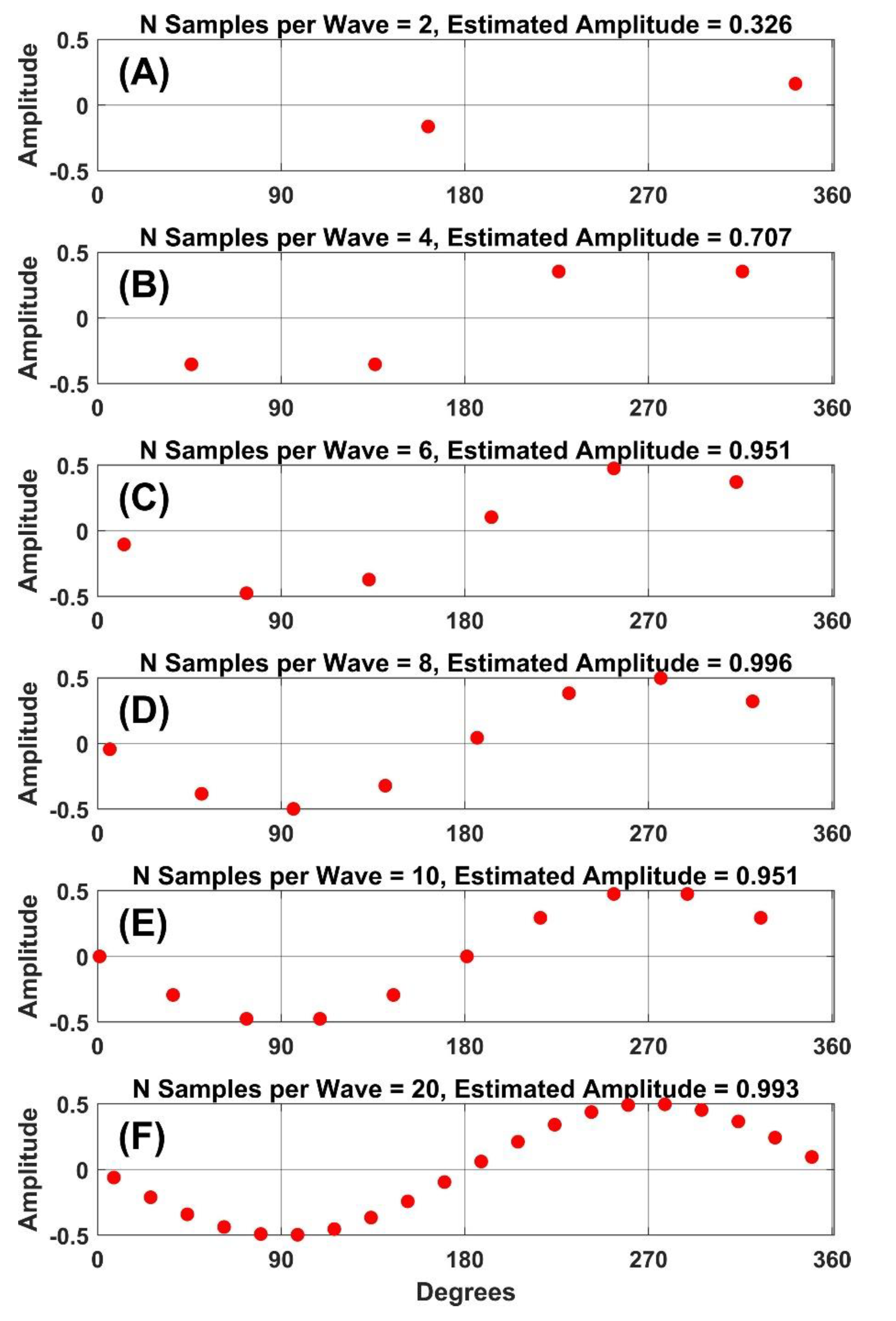
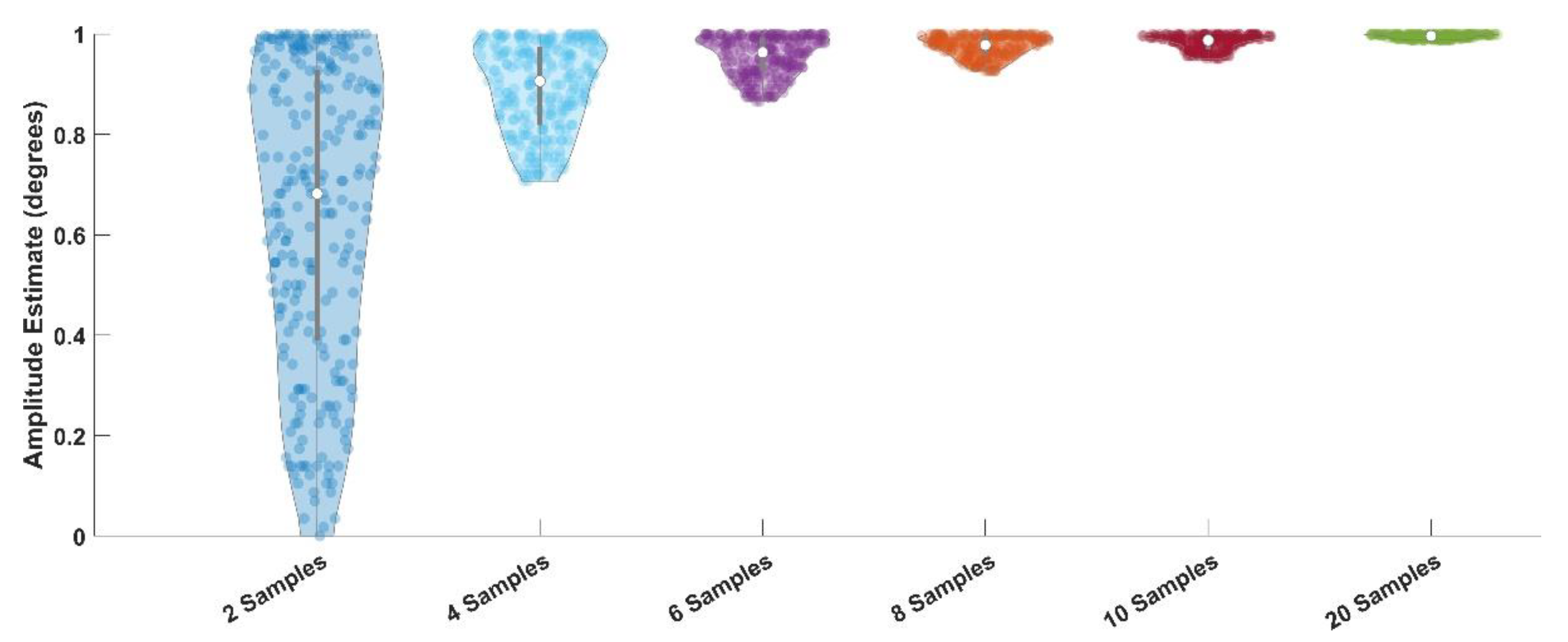
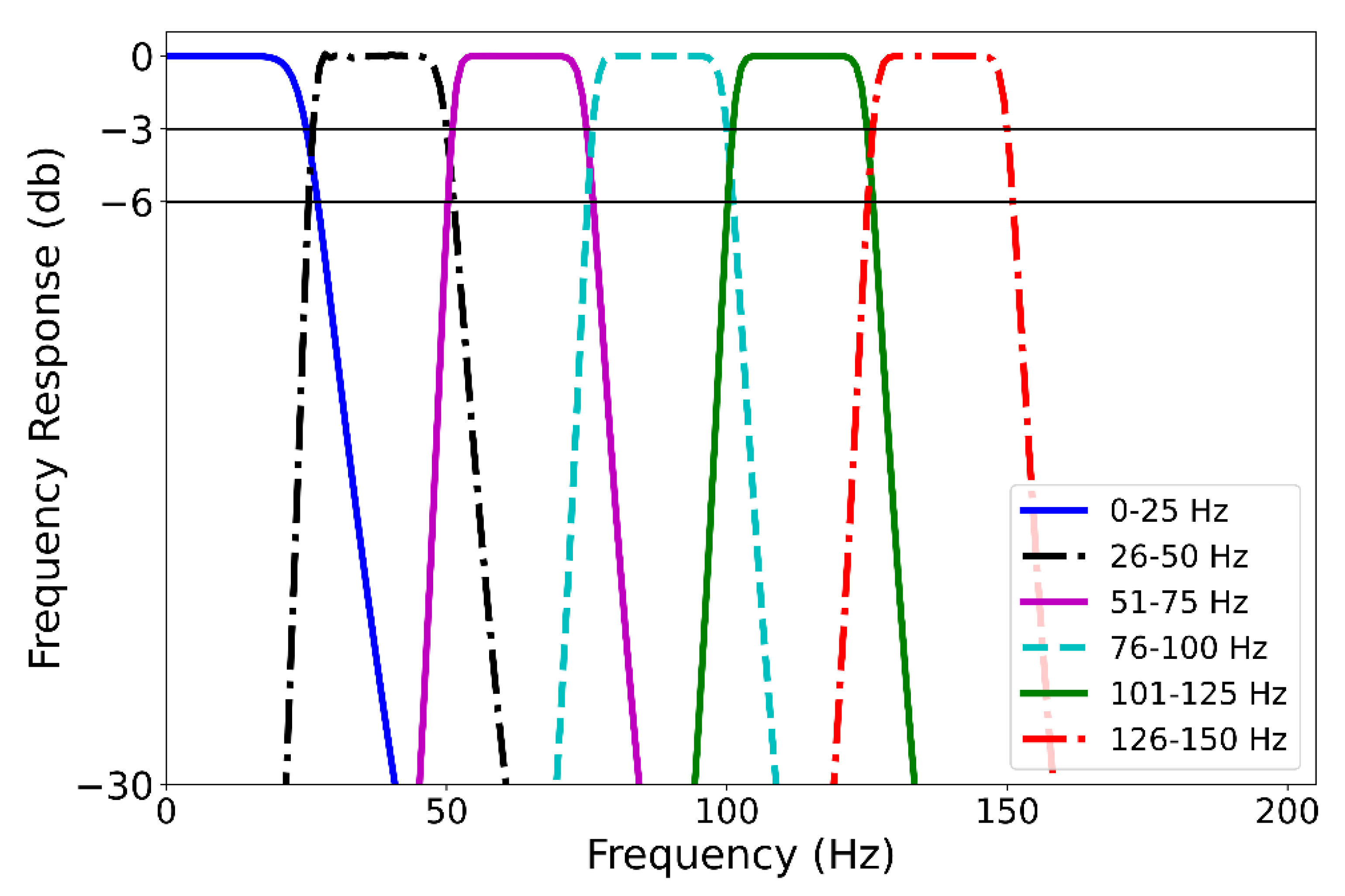
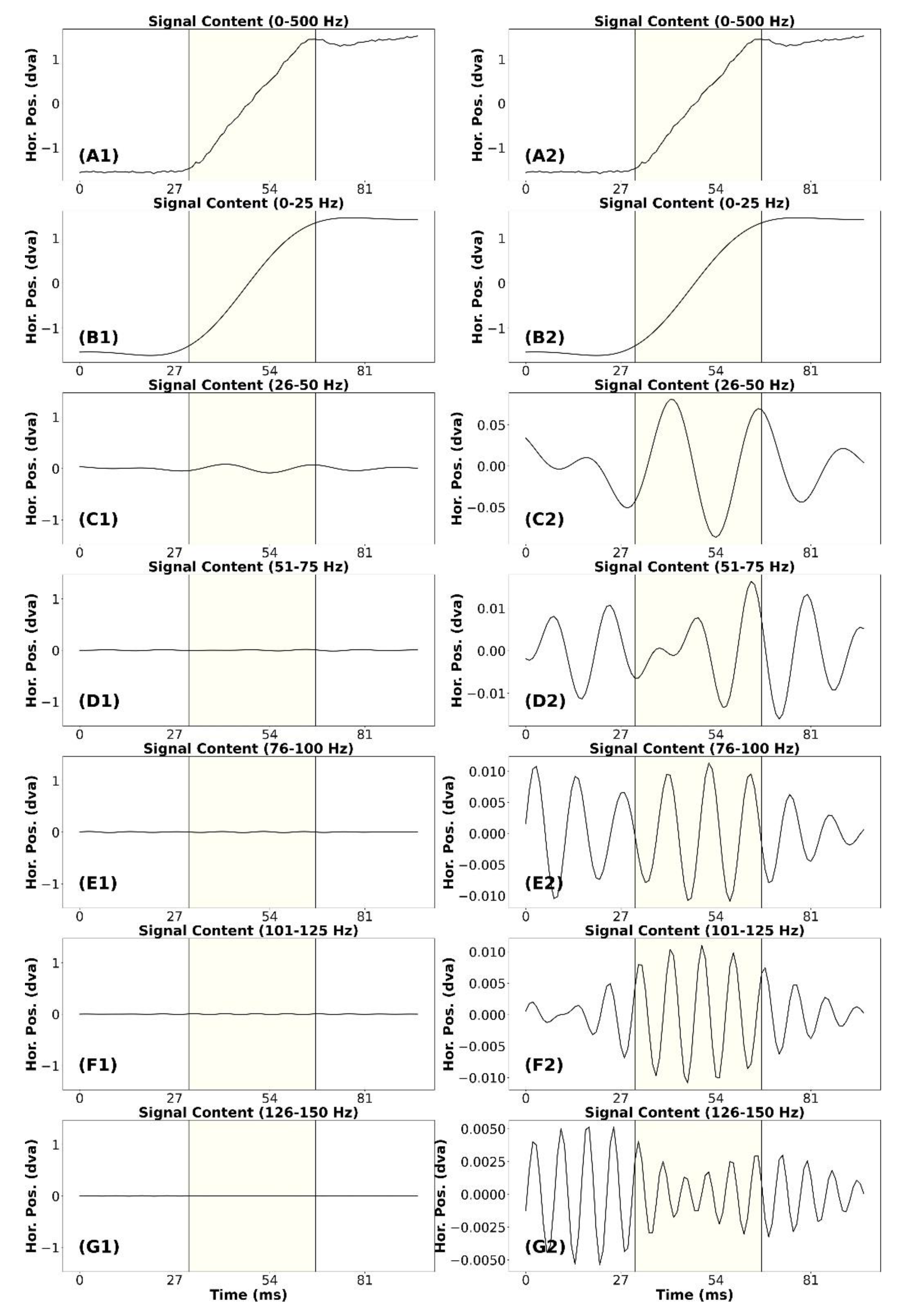
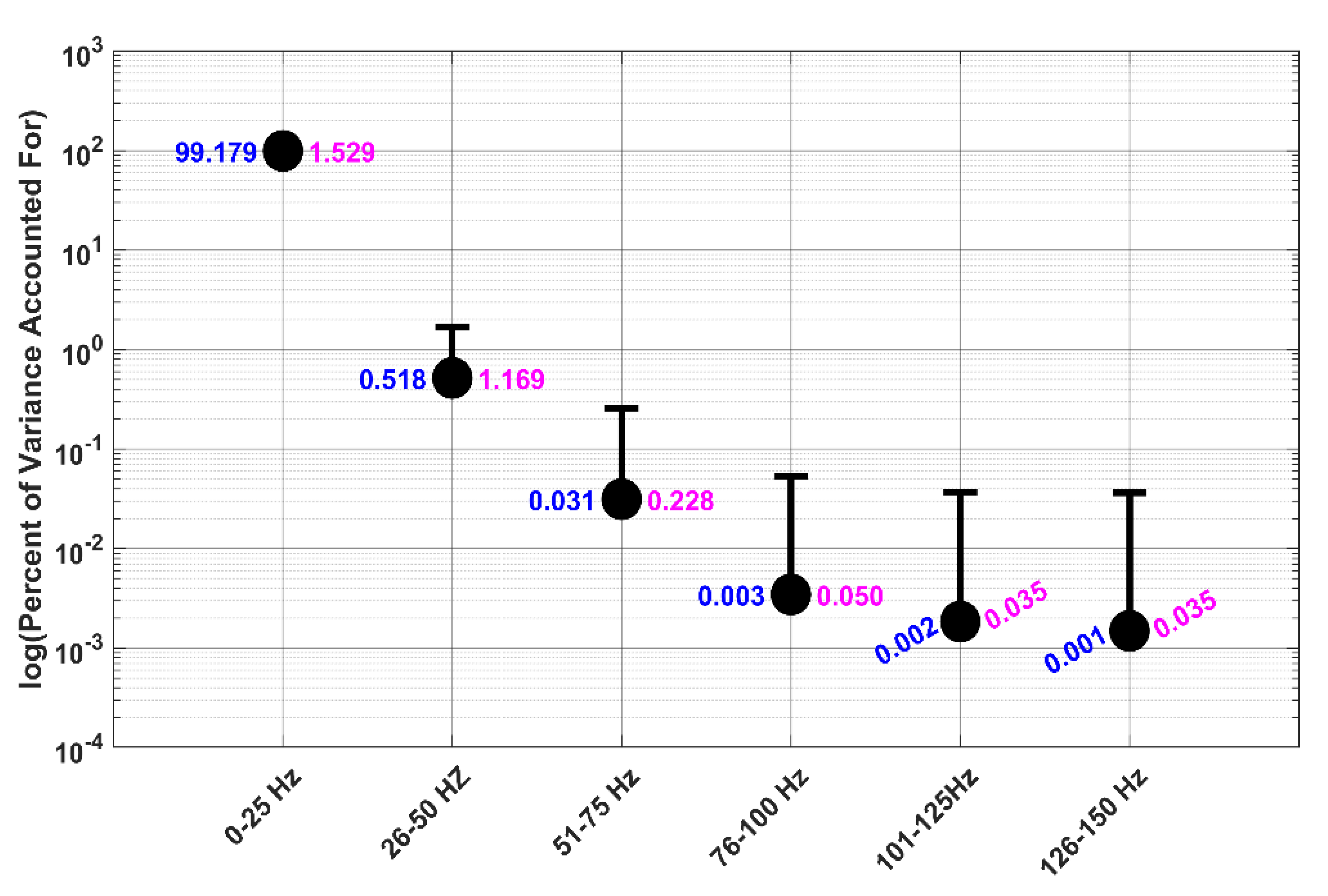

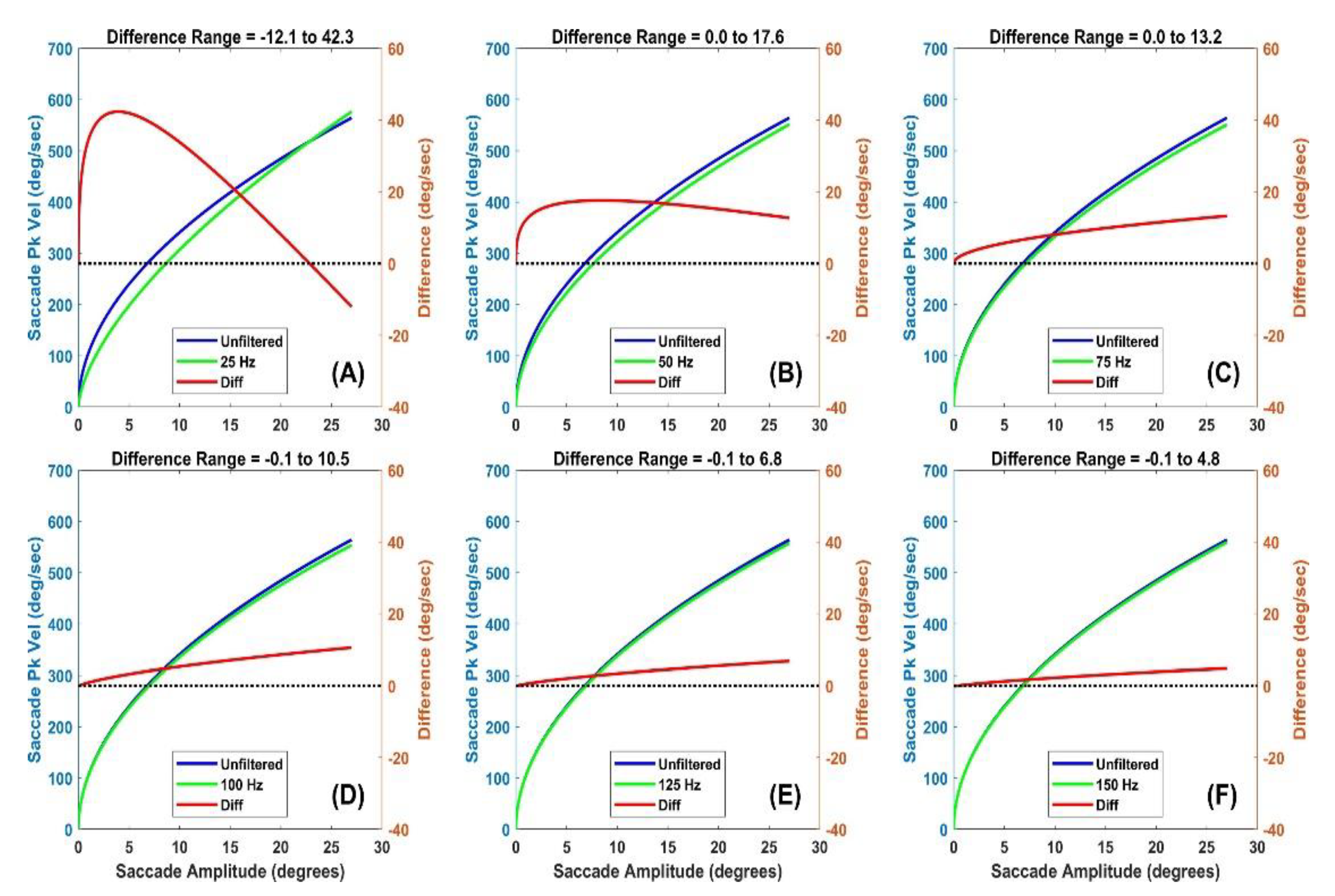

| Citation | Methods | Findings |
|---|---|---|
| Bahill (1981) | Photoelectric techniques | For noisy data, a bandwidth of 0-125 Hz was required to record saccades. Also, a sampling rate of 1000 Hz was suggested. |
| Schmitt et al. (2007) | Video-based infrared eyetracker | Sampling rate should be 250 Hz. |
| Wierts et al. (2008) | VOG and Search coil | Saccadic eye movements of >=5° amplitude were band width limited up to a frequency of 25 to 30 Hz. A sampling frequency of about 50 Hz was sufficiently high to prevent aliasing. |
| Mack et al. (2017) | Synthetic saccades | Signals sampled as low as 240 Hz allow for the good reconstruction of peak velocity. With 240 Hz, the frequencies that can be evaluated were 0-24 Hz (in the time domain). |
| Evidence | Method | What is Signal | What is Noise |
|---|---|---|---|
| Exemplars | Visual Inspection of Saccade | 0-50Hz | 51-500 Hz |
| Visual Inspection of Microsaccade | 0-75Hz | 76-500 Hz | |
| Visual Inspection of CUS | 0-50Hz | 51-500 Hz | |
| Variance | Compute percent of variance | 0-25 Hz | 26-500 Hz |
| Explained | accounted for in unfiltered saccades | ||
| Main Sequence analysis | Power Law Coefficients | 0-75 Hz | 76-500 Hz |
Disclaimer/Publisher’s Note: The statements, opinions and data contained in all publications are solely those of the individual author(s) and contributor(s) and not of MDPI and/or the editor(s). MDPI and/or the editor(s) disclaim responsibility for any injury to people or property resulting from any ideas, methods, instructions or products referred to in the content. |
Copyright © 2023. This article is licensed under a Creative Commons Attribution 4.0 International License.
Share and Cite
Raju, M.H.; Friedman, L.; Bouman, T.M.; Komogortsev, O.V. Determining Which Sine Wave Frequencies Correspond to Signal and Which Correspond to Noise in Eye-Tracking Time-Series. J. Eye Mov. Res. 2021, 14, 1-19. https://doi.org/10.16910/jemr.14.3.5
Raju MH, Friedman L, Bouman TM, Komogortsev OV. Determining Which Sine Wave Frequencies Correspond to Signal and Which Correspond to Noise in Eye-Tracking Time-Series. Journal of Eye Movement Research. 2021; 14(3):1-19. https://doi.org/10.16910/jemr.14.3.5
Chicago/Turabian StyleRaju, Mehedi H., Lee Friedman, Troy M. Bouman, and Oleg V. Komogortsev. 2021. "Determining Which Sine Wave Frequencies Correspond to Signal and Which Correspond to Noise in Eye-Tracking Time-Series" Journal of Eye Movement Research 14, no. 3: 1-19. https://doi.org/10.16910/jemr.14.3.5
APA StyleRaju, M. H., Friedman, L., Bouman, T. M., & Komogortsev, O. V. (2021). Determining Which Sine Wave Frequencies Correspond to Signal and Which Correspond to Noise in Eye-Tracking Time-Series. Journal of Eye Movement Research, 14(3), 1-19. https://doi.org/10.16910/jemr.14.3.5



